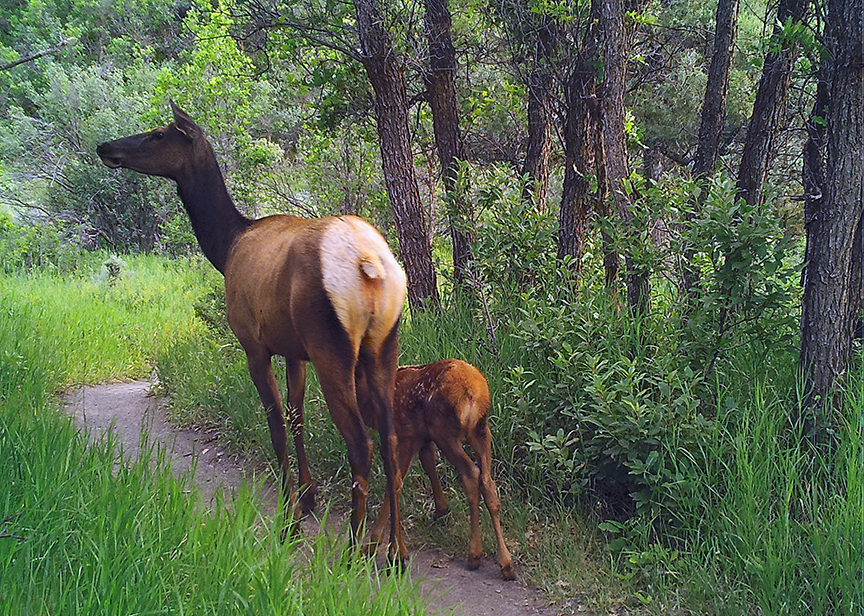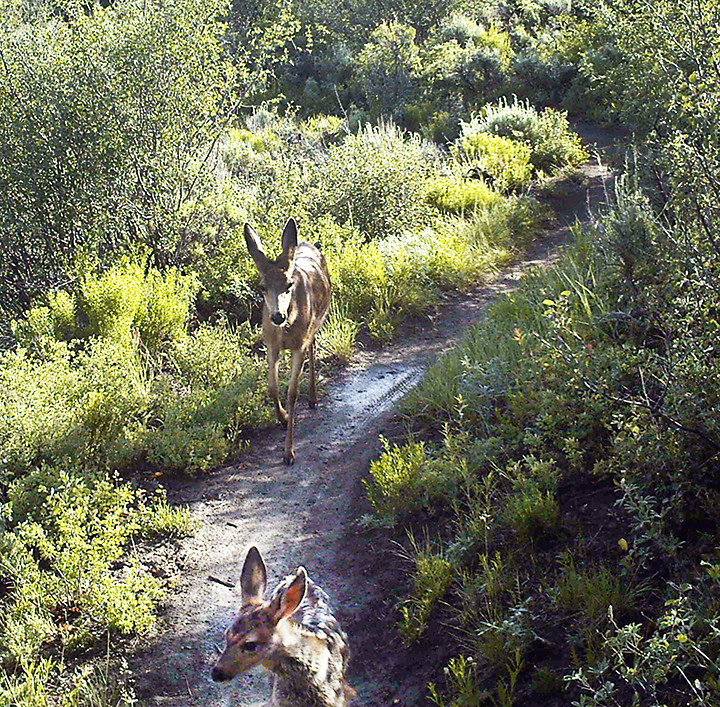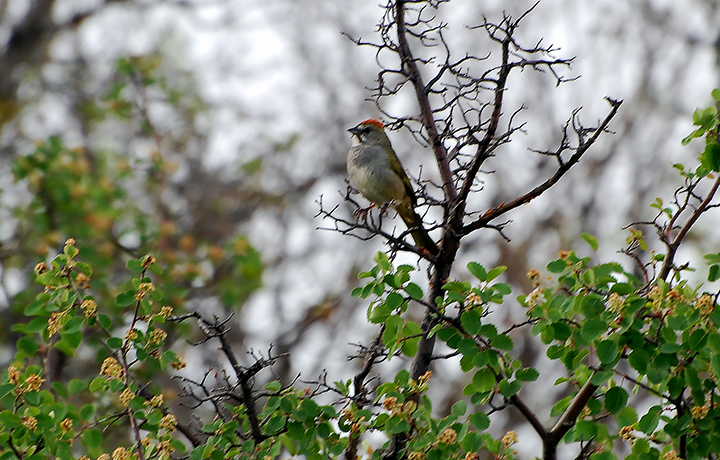Managing Sky Mountain Park for many users

A cow elk and calf at Sky Mountain Park in July 2022.
The hikers and mountain bikers who hit the trails of Sky Mountain Park on opening day (May 16) will join an impressive array of mammals and birds on the landscape – a testament to successful management of the area for both wildlife needs and human recreation.
The 2,500-acre assemblage of open space properties on the edge of Snowmass Village will reopen after a 5 ½-month closure to protect wild animals, particularly elk and deer, during the harsh winter months. The most recent, comprehensive wildlife survey at the park, however, confirms many other species also call the open space home. Animals that inhabited the heart of the park when it first opened to public use (in 2011) continue to occupy its shrublands, riparian zones and aspen groves, even with annual trail use numbers that regularly top 8,000 over the months when the park is open.
Management actions, including the wintertime closure to humans, a dog prohibition across much of the park, a dawn-to-dusk closure and regulations that restrict human use only to the designated trails, are aimed at wildlife protection. These actions minimize disturbance and give mammals space to move, eat, sleep, rest, give birth and rear their young in the spring, and time for birds to nest.
Pitkin County Open Space and Trails has contracted periodic wildlife and vegetation surveys at the park since 2011 to document the health of the ecosystem. The monitoring tracks changes to wildlife and plants over time, helps in assessing the effectiveness of current management practices and guides changes in how the open space is managed for habitat and recreation. This quantitative information is important for adaptive management of the resources.
The most recent wildlife report, prepared by Colorado Wildlife Science of Basalt and based on field studies completed in 2020 and 2021, showed a jump in the presence of some mammals, notably deer and elk, but concluded that the increase is likely attributable to environmental variations such as snowpack rather than an actual increase in abundance.
Sky Mountain Park “encompasses some of the most important migration corridors in the upper Roaring Fork Valley and provides high-quality transition habitat,” the report said.
Some cow elk use the property to rear their calves and as summer range. Bulls use the open space year-round, as well. Elk calving has not been documented at Sky Mountain Park (SMP), but it likely occurs there and wildlife cameras have photographed elk calves.
“Given, however, the number of solitary cows captured by the cameras on both sides of the property during the height of calving season, it is likely that there is indeed some parturition (birthing) occurring at SMP,” the report noted.
The park also serves as winter and summer range for mule deer, and likely as fawning habitat, according to the report.
The wildlife surveys have detected 11 mammalian species in the park since 2011. In 2021, the top five most documented were elk, mule deer, least chipmunk, black bear and mountain cottontail.
Two federally protected species could occur at the park, though neither has ever been documented there – Canada lynx and gray wolf. The park could be used by a lynx passing through, though it does not provide suitable denning or winter habitat. Gray wolves, slated to be reintroduced to Colorado, could eventually inhabit Sky Mountain Park.
“Once gray wolves are introduced to Colorado, it is likely they will occur at SMP,” the report said, recommending Open Space and Trails consider the species in future management decisions.
One species considered a “species of concern” by the Forest Service – the Pacific marten – has been documented in the park.
Among the 72 bird species that have been recorded at the park since surveying began, 19 are designated by one or more governmental agencies or conservation organizations as having special status or have been found to be in decline. A Northern harrier and Canada jay were documented at Sky Mountain Park for the first time in 2020. The harrier, a hawk, is categorized as a Species of Greatest Conservation Need by Colorado Parks and Wildlife.
When the park opens in mid-May, visitors are likely to see and hear Green-tailed towhees – the most common bird species at the park. More than 150 of the birds were detected in the most recent field survey.
Three bird species known to be sensitive to human activity and habitat alteration – Brewer’s sparrow, Virginia’s warbler and Green-tailed towhee – were all detected in substantial numbers in appropriate habitat. In contrast, birds that live closely alongside humans (think crows, robins and magpies, for example) were detected in low numbers or not at all.
“This is a relatively robust indicator of habitat integrity, suggesting that despite the mixed use management of SMP, it continues to provide effective habitat for sensitive bird species,” the report concluded.
Owls, also considered indicators of ecological health, are among the bird species found at Sky Mountain Park. In addition to the Great-horned owl and Flammulated owl, an additional species – the Northern saw-whet owl – was detected in the park for the first time in 2021. A Common nighthawk was detected for the first time, as well.
Opening day at Sky Mountain Park will give human visitors an opportunity to see animals that have had the park to themselves since last December. Watch and listen. Be mindful of other critters along the trails.
– By Pitkin County Open Space and Trails
KEY LINK
Sky Mountain Park Annual Wildlife Monitoring Report – 2020 & 2021 Field Seasons – will be published on OST’s Ecofinder repository of ecological reports in the near future.

A mule deer and a fawn on Viewline Trail at the park.

A Green-tailed towhee at Sky Mountain Park.
